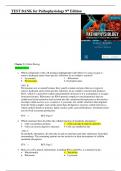Exam (elaborations)
Test Bank For McCance & Huether’s Pathophysiology 9th Edition By Julia Rogers ,ISBN: 9780323789875 || Complete Guide A+
This Is Original 9th Edition of Test Bank From Original Author. All Other Files in the market are fake/old Edition. Other Sellers Have changed old Edition Number to new But Test Bank is old Edition. Test Bank for McCance & Huether’s Pathophysiology 9th Edition By Julia Rogers (All Chapters, 100% ...
[Show more]



